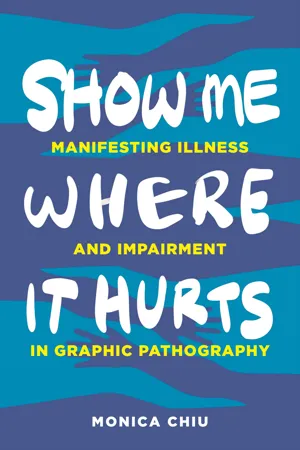
Show Me Where It Hurts
Manifesting Illness and Impairment in Graphic Pathography
- English
- ePUB (mobile friendly)
- Available on iOS & Android
About this book
In Show Me Where It Hurts, Monica Chiu argues that graphic pathography—long-form comics by and about subjects who suffer from disease or are impaired—re-vitalizes and re-visions various negatively affected corporeal states through hand-drawn images. By the body and for the body, the medium is subversive and reparative, and it stands in contradistinction to clinical accounts of illness that tend to disembody or objectify the subject.
Employing affect theory, spatial theory, vital materialism, and approaches from race and ethnic studies, women and gender studies, disability studies, and comics studies, Chiu provides readings of recently published graphic pathography. Chiu argues that these kinds of subjective graphic stories, by virtue of their narrative and descriptive strengths, provide a form of resistance to the authoritative voice of biomedicine and serve as a tool to foster important change in the face of social and economic inequities when it comes to questions of health and healthcare. Show Me Where It Hurts reads what already has been manifested on the comics page and invites more of what demands expression.
Pathbreaking and provocative, this book will appeal to scholars and students of the medical humanities, comics studies, race and ethnic studies, disability studies, and women and gender studies.
Frequently asked questions
- Essential is ideal for learners and professionals who enjoy exploring a wide range of subjects. Access the Essential Library with 800,000+ trusted titles and best-sellers across business, personal growth, and the humanities. Includes unlimited reading time and Standard Read Aloud voice.
- Complete: Perfect for advanced learners and researchers needing full, unrestricted access. Unlock 1.4M+ books across hundreds of subjects, including academic and specialized titles. The Complete Plan also includes advanced features like Premium Read Aloud and Research Assistant.
Please note we cannot support devices running on iOS 13 and Android 7 or earlier. Learn more about using the app.
Information
Table of contents
- Cover
- Title Page
- Copyright
- Dedication
- Contents
- List of Illustrations
- Acknowledgments
- Introduction: Making Illness and Impairment Manifest
- 1. Graphic Genesis and the Somatic Text: Davison’s The Spiral Cage
- 2. Facing Cancer, the Face of Cancer: Beauty, Health, and Affect in Marchetto’s Cancer Vixen and Ann Tenna
- 3. Aging by Frames: Thready Lines, Haptic Images, and Institutions of Care in Chast’s Can’t We Talk About Something More Pleasant? and Farmer’s Special Exits
- 4. Hospital Waiting Rooms as Medicine’s Sedimented Spaces: Ware’s Jimmy Corrigan and Potts’s Good Eggs
- 5. Graphting and the Model Minority in Chong and Webber’s Dancing After TEN
- 6. Vital Viruses: Animating Herpes, Pathologizing Whiteness in Dahl’s Monsters and Schulz’s Sick
- Conclusion: Uncharted; Graphic Medicine by Medical Interns
- Coda: The Absent Presence of Race; Racial Essentialism and Graphic Pathography
- Notes
- Bibliography
- Index